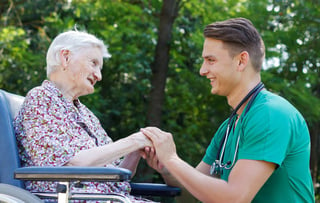 Parkinson’s disease is a brain disorder that causes tremors, balance problems and changes to gait and speech. About 1.5 million Americans currently suffer from the disease, and some 60,000 new cases are diagnosed every year. The condition most often strikes seniors, affecting about 18 out of every 1,000 people over age 65.
Parkinson’s disease is a brain disorder that causes tremors, balance problems and changes to gait and speech. About 1.5 million Americans currently suffer from the disease, and some 60,000 new cases are diagnosed every year. The condition most often strikes seniors, affecting about 18 out of every 1,000 people over age 65.
At Presbyterian Senior Living, we understand that aging with Parkinson’s disease can be incredibly difficult, and we’re spreading the word that people dealing with this disease can maintain a high quality of life. In recognition of April as Parkinson’s Awareness Month, we want to share some important information about recognizing the symptoms and learning more about what you can do to help someone suffering with the disease.
What Are the Symptoms of Parkinson’s?
The most frequent symptom of Parkinson’s disease in seniors is involuntary shaking or tremor, which often occurs in the hands but can affect other parts of the body, including the jaw, leg and lower lip. Additional primary indicators include:
- Stiff, tight or achy muscles in the trunk, legs or arms, either on one side or on both sides of the body.
- Slow movement, known as bradykinesia. Individuals suffering from Parkinson’s can have difficulty with dressing, getting out of bed and speaking.
- Postural instability, including falls and balance problems. An individual with this symptom may have difficulty with walking, turning around and staying balanced.
Secondary symptoms can include:
- Slight dragging of feet or a shuffling gait.
- Freezing in place when trying to walk.
- Loss of expression in the face due to rigid muscles.
- Muffled or quiet speech.
- Falling backward, known as retropulsion.
- Mood disorders, including anxiety and depression.
- Very small handwriting, known as micrographia.
- Reduced swinging of the arm on the affected side when walking.
- Impaired ability to blink or swallow.
- Cognitive changes, including slowed thought, problems with memory and language, and dementia.
- Delusions and hallucinations.
- Sleep disorders.
- Pain and fatigue.
- Diminished sense of smell.
How Can You Help Those Living with Parkinson’s?
It’s important to support your loved one with Parkinson’s as much as possible by learning about the disease, adapting your routine as necessary and offering to share responsibilities associated with care. People with Parkinson’s will be willing to accept different degrees of assistance; you may be able to help with transportation and support for doctor and therapy appointments, administering medications, cleaning and maintaining the individual’s home, and other duties that may become difficult because of the disease.
You also can help by staying in communication with your loved one so you can recognize subtle changes or new symptoms that the individual may not realize are happening. As physical changes occur, you can suggest and help facilitate alternatives to beloved activities, such as attending concerts rather than playing an instrument.
How Can You Participate in Raising Awareness This Month?
If you’d like to help raise awareness of Parkinson’s disease, you can make use of online resources from the Parkinson’s Disease Foundation, including a free toolkit, posters, tree ribbons, and a social media badge. To learn more about how Presbyterian Senior Living helps individuals with Parkinson’s continue to live a vibrant life, please contact us.